Airfield Viewing Guide - RAF Waddington
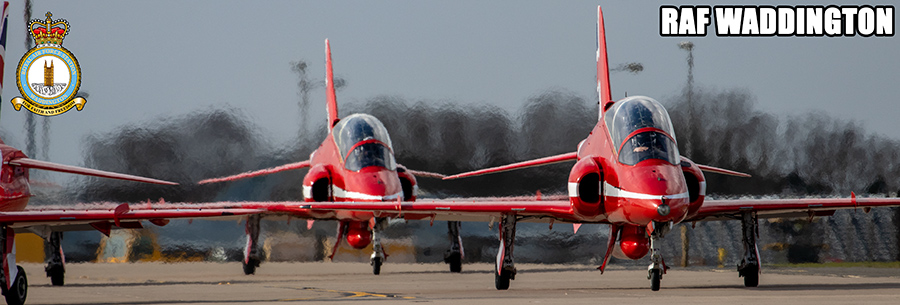
General Description
RAF Waddington is located East of Waddington village, between the A607 and A15, 3 miles South of Lincoln in Lincolnshire. "Waddo", as it is popular known, is home to No.34 Expeditionary Air Wing, the RAF's ISTAR (Intelligence, Surveillance, Target Acquisition & Reconnaissance) centre, consisting of 13 Squadron (Reaper), 14 Squadron (Shadow R.1), 39 Squadron (Reaper - none actually based at Waddington though), 51 Squadron (RC-135W Rivet Joint) and 54(R) Squadron (ISTAR training on all based types - no airframes of their own really though their badge has appeared on the E-3s in the past alongside the 8 Squadron badge) as well as various entirely ground-based supporting units and squadrons. The Red Arrows are also now based here. Vulcan XM607 of 'Black Buck' Falklands fame is preserved on the station and normally parked near the viewing area - at the time of writing, however, it is elsewhere on the station having some restoration work carried out on it.
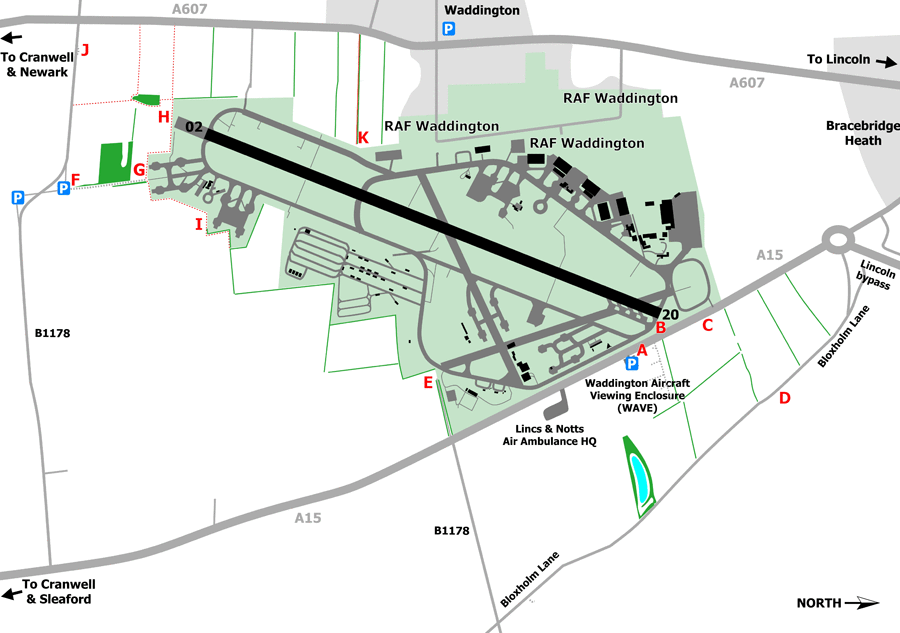
| ICAO | Telephone | Web links |
|---|---|---|
| EGXW | 01522 720271 | RAF Waddington |
| Sentry Post snack bar & shop (WAVE, currently closed) | ||
| Lincs. & Notts. Air Ambulance | ||
| Aerial view |
| Frequencies | |
|---|---|
| Frequency | Description |
| 121.3 | Tower/Ground |
| 119.5 | Zone |
| 122.1 | Tower NATO |
| 123.3 | Approach NATO |
| 125.35 | Zone |
| 127.35 | Radar |
| 128.95 | Approach |
| 291.675 | ATIS |
| 231.8 | Radar |
| 232.35 | Radar |
| 232.7 | Zone |
| 234.625 | Ops |
| 241.325 | Tower |
| 280.175 | Director |
| 297.975 | Shadow Ops |
| 342.125 | Ground |
| 343.975 | Aden Ops |
| 344.2 | PAR |
| 345.075 | Approach |
| 362.3 | Approach NATO |
| 369.4 | Vulcan Ops |
| 376.2 | PAR |
| Last updated | 5th August 2021 |
What you can expect to see
Waddington is now busier than in recent years, with regular Red Arrows practice sessions and a a mixture of movements from the other based types (Shadow and RC-135), occasional practice approaches from Cranwell's Prefects and Phenoms, and occasional visitors such as NATO E-3s, RAF helicopters stopping for fuel and so on. The Lincs & Notts Air Ambulance is also based in a compound opposite the airfield and is a common sight. While the regular foreign fighter deployments ceased with the closure of the North Sea ACMI ranges, Waddington still hosts some major exercises - Cobra Warrior in particular, which is usually around 3 weeks of varied action from foreign visitors twice a year.
Waddington is a 24-hour emergency diversion airfield, so occasionally aircraft will divert here if they have problems or their destination is weathered in. As the station is basically shut down over the weekend though, anything diverting here between Friday afternoon and Sunday is stuck there until Monday! Other infrequent users of Waddington are civilian aircraft using the runway for training - something RAF types do much more often of course.
Viewing
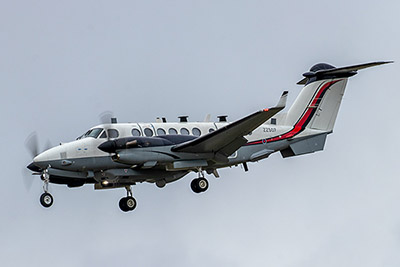
Shadow on final approach (taken from WAVE, point A - 400mm); author
This station is easily found alongside the A15 just south of Lincoln, with the Waddington Aircraft Viewing Area (WAVE) signposted just before you get to it (A). WAVE used to be one of the best viewing areas in the country, with lots of (paved!) parking, toilets (airshow style) plus, believe it or not, the Sentry Post Snack Bar and Shop. However, the operators of Sentry Post have shut up shop and currently the entire site, parking and all, is closed except when specifically opened up by the RAF Police. Sitting here in the car park you can get passable shots of aircraft landing on runway 20, or departing from runway 02, but for really good shots you'll need to get walking.
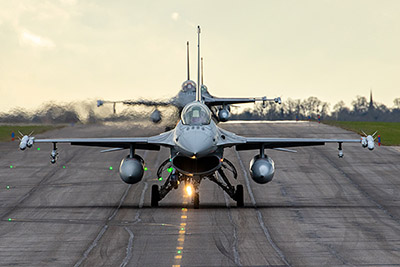
F-16s taxiing (taken on stepladder south of point B; 250mm); author
So, out of your car and cross the road - the A15 is very busy with fast-moving traffic, so take care. On this side of the road (B) there is now a tall fence with an even taller hedge - gone are the days when it was easy to photograph aircraft taxiing past. So, you'll need a decent ladder for any view - what that gives you is truly excellent views of aircraft taxiing at close range - a 28-200 size lens will do for stuff on the taxiway, up to 300-400mm lenses for fighters ending their landing run on 02 (or landing on 20) or smaller for larger aircraft like E-3s. You can also look South down the taxiway to sometimes see at least the tails of aircraft parked up on the dispersals there - no good for photos because of obstructions but possibly useful for serials. As they taxi out of these dispersals heat haze and distance tends to make photos fairly pointless.
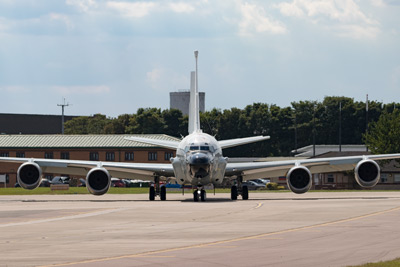
RC-135 taxiing out (taken from north of point B); author
Looking across the airfield to the Northernmost hangar (the modern looking one) you'll currently see some retired E-3s parked outside; photos aren't really worth the bother because of obstructions though a 300mm lens can frame an E-3 over there quite well. Aircraft departing from 02 will usually lift off out of sight over the hump of the runway and are a little high by the time they get close to you, but passable shots can be had. Aircraft departing from 20 or landing on 20 give you even better photo opportunities, and the RC-135s tend to take the western taxiway from their apron to depart from 20, which offers some nice head-on photos as they turn here.
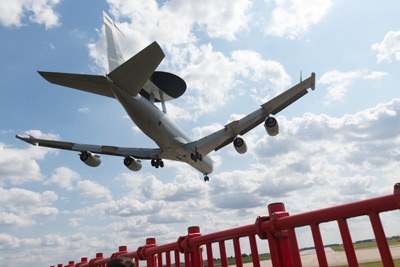
Sentry on final (taken from north of point B, 150mm); author
Further up the road the hedge disappears but the fence continues, so a smaller stepladder can suffice. Then you'll get to the frangible red and white fence at the runway end, this has pretty big gaps so you can photograph through the bars. The previous wooden fence had been blown over a few times in recent years by departing or landing aircraft so it's not a healthy place to hang around for long at, and if it gets busy here the RAF security patrols or civilian police may move you on. The opposite side of the road (C) is a little safer though obviously offers no view inside the airfield itself. The wide verge on the airfield side does at least offer a bit more separation from the busy A15 traffic so that you can reposition at will as the light changes through the day.
There's one further spot good for arrivals to runway 20, or aircraft circuit bashing on 02. Bloxholm Lane runs to the North-East of the A15 and smaller aircraft often turn over it, providing good topside photo opportunities. Larger aircraft circuit bashing on 02 sometimes turn quite tightly on departure giving similar opportunities. So, back to the car and drive out of the WAVE, turning right, then taking the third exit on the roundabout into Bloxholm Lane just before you reach Bracebridge Heath. Now if you keep an eye out on your right you'll soon see the approach lights again. There are a number of places where you can pull off the road to park (particularly on the wide flat verge on the right e.g. D). Anyway, basically the whole length of this road can be useful, it depends entirely on the style of circuit aircraft are carrying out. If you're lucky you can get some nice top-side shots as they bank hard over to bring themselves onto the approach for 20 or downwind for 02. As always the bigger your lens the better; 400mm is really a minimum for this style of shot and frankly on most days you'll need much more.
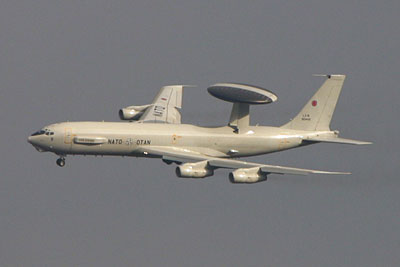
NATO E-3 turning onto finals (taken from near point D, 800mm); author
The next spot is more for spotters than photographers - back to the car and continue down the road, turning right onto the B1178. As you reach the A15 you'll see a track straight ahead. This runs along part of the southern perimeter of the station. It is gated, and sometimes locked, although ownership of it is not clear (MoD or farmer). Either way, enthusiasts regularly drive up it (E) to get more views of any aircraft parked in the dispersals nearby (a rarity these days!), often providing another serial or two, mostly without serious hassle from the station or from the farmer. I would recommend parking nearby and walking (in case the gates are locked after driving up!) and being courteous to anyone challenging you.
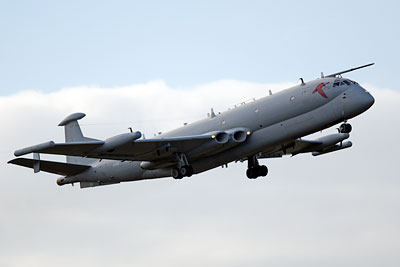
Nimrod on approach (taken from point F, 600mm); author
There are a lot of dispersals down at the southern end of the airfield, and these are sometimes used by visitors, or even residents so it can be worth a look here just to make sure. Also, of course, if runway 02 is in use then for any approach shots you need to get to the Southern end of the airfield anyway. To do so, drive South on the A15 and turn right to head West on the B1178. After approximately 1.5 miles the road bends to the right and then to the left; as it bends right there's a lane running North (actually an old Roman road). This lane has become very rough in recent years with some suspension-killing potholes and often lots and lots of mud so it's best to leave your car at the start of the lane (F). Large aircraft on approach can be photographed from here, but you need a big lens - 500mm+.
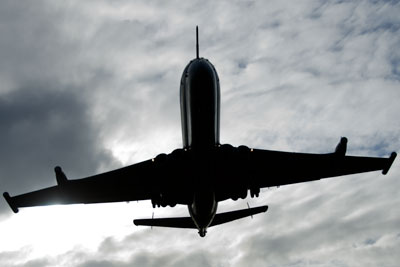
Nimrod on final (taken from point H, 75mm); author
So, it's best to walk the rest of the way to the crash gate (G). From here you're right next to a large dispersal (at the time of writing, storage for two out of service Sentinel airframes) and can look across to the 02 threshold; nice landing shots in the morning if you have a big lens (300mm plus, less for larger types) - but only of them airborne, the large lighting poles along the fence ruin the view as they pass to your right. You can also walk along the fence between the new wire-mesh fence and the old wooden fence/hedge (i.e. keeping off the farmer's fields) if you need to. The RAF police do sometimes move people on from here so if you intend to stay at this end for some time it really is best to leave your car further down the lane rather than anywhere near the crash gate and its horrific potholes.
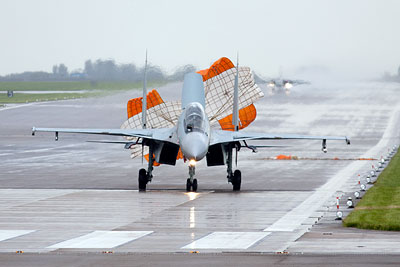
Su-30 taxiing off runway (taken from east of point H, 680mm); author
To get closer to the runway end, simply continue walking west following the station fence and you'll soon see the approach lights (H). Not only can you get great head-on or side-on landing shots from around here, you can also catch aircraft touching down (from behind naturally) or completing their landing roll on 20 - though you'll need a stepladder to see over the fence. It's obviously not the safest place in the world so try and keep off the direct centreline and don't be surprised if you do get asked to leave on some days. Locals do tend to use the field edges round here as unofficial footpaths e.g. for dogwalking so you can also reach this spot from the A607 if need be.
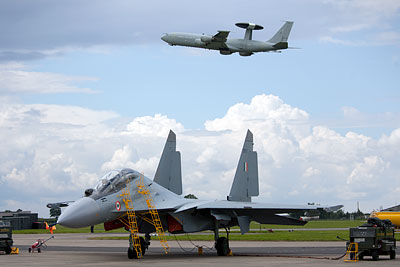
Su-30 parked (taken from near point I, 130mm); author
Returning to the crash gate, there is another dispersal that can - sometimes - be reached by walking to the right of the gate, following the station fence once again. This does get very tight in some places where you'll have to squeeze past hedges etc. (and is impassable in summer) but it does lead to the final dispersal worth checking out (I). The viewing is not easy as there is a high chainlink fence but some shots can be had through the chainlink, or if you want to go to the trouble of bringing a large stepladder there are a few spots where the ground is stable enough to use it to take photos over the top of the fence. It has to be said that station security aren't keen on spotters venturing down here, and as it is unusual for anybody to bother doing so, you will almost certainly attract a response. On that basis it is best to steer clear of this particular spot unless there is something particularly juicy parked up that has already attracted a crowd (the last time this occurred was the Indian Su-30 deployment in 2007, so quite a long time ago).
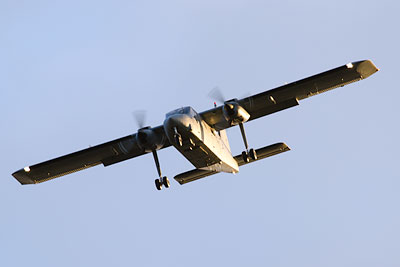
Islander on approach (taken from point J, 650mm); author
Back down the lane and turn right to get back onto the B1178 and just before you reach the A607 crossroads there are a couple of places off the side of the road where you can park (only room for one car on one and two or three on the other though); e.g. by a field entrance (J). Aircraft on approach to 02 pass nearly overhead here, but are usually quite high so photographically it's a bit of a dead loss. One further spot not well known is a footpath that is about 200 meters South of Waddington village, leading off the A607 and going right up to the airfield perimeter fence (K). From here a 300-400 mm lens will give you good shots, but it's only useful in the late afternoon because of the sun's position earlier in the day. It does offer good views across to the dispersals, depending on which ones are in use of course, but they are too distant for photography.
That's about it for Waddo; there is one preserved airframe on the station - the Vulcan - but at the time of writing it is out of sight in the hangars being restored.
Other Information
RAF Waddington used to host a major two-day airshow each year, which was well worth attending, but sadly it has been permanently withdrawn from the calendar. The general attitude to spotters at Waddington is pretty relaxed; during the airshow and some exercises, however, the parking restrictions were draconian and access to the southern end of the airfield was monitored much more closely. Petrol and shops available in Waddington village.
RAF Coningsby is about 30 minutes away to the East via the A17 and A153 and RAF Cranwell is about 20-30 minutes away to the South via the A15 or A607.
Contributors: Nick Challoner, Michael Anderson, author, Gary Parsons, Milscanners.
